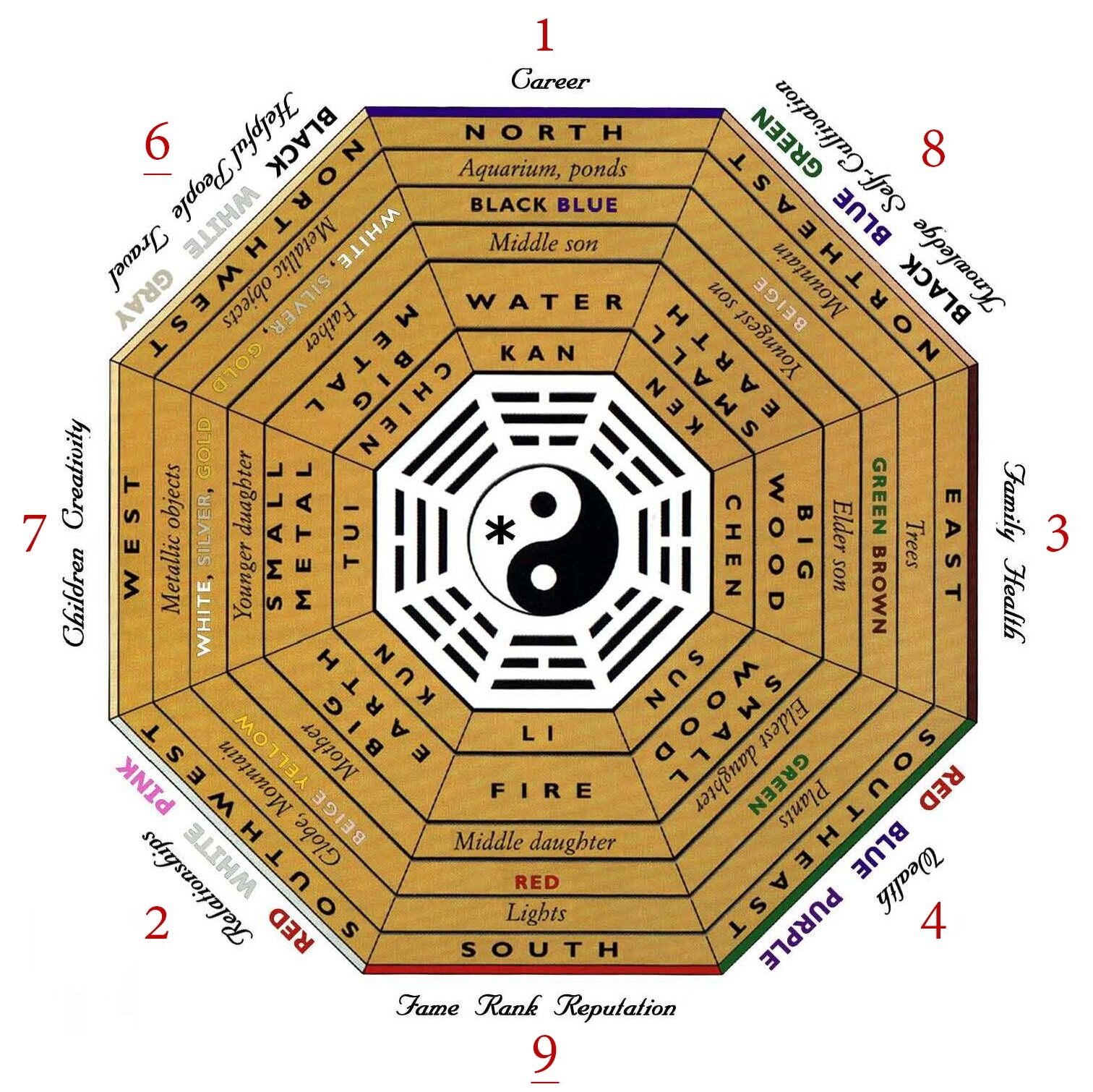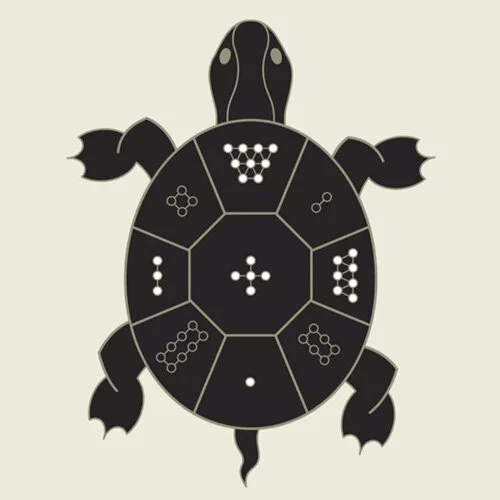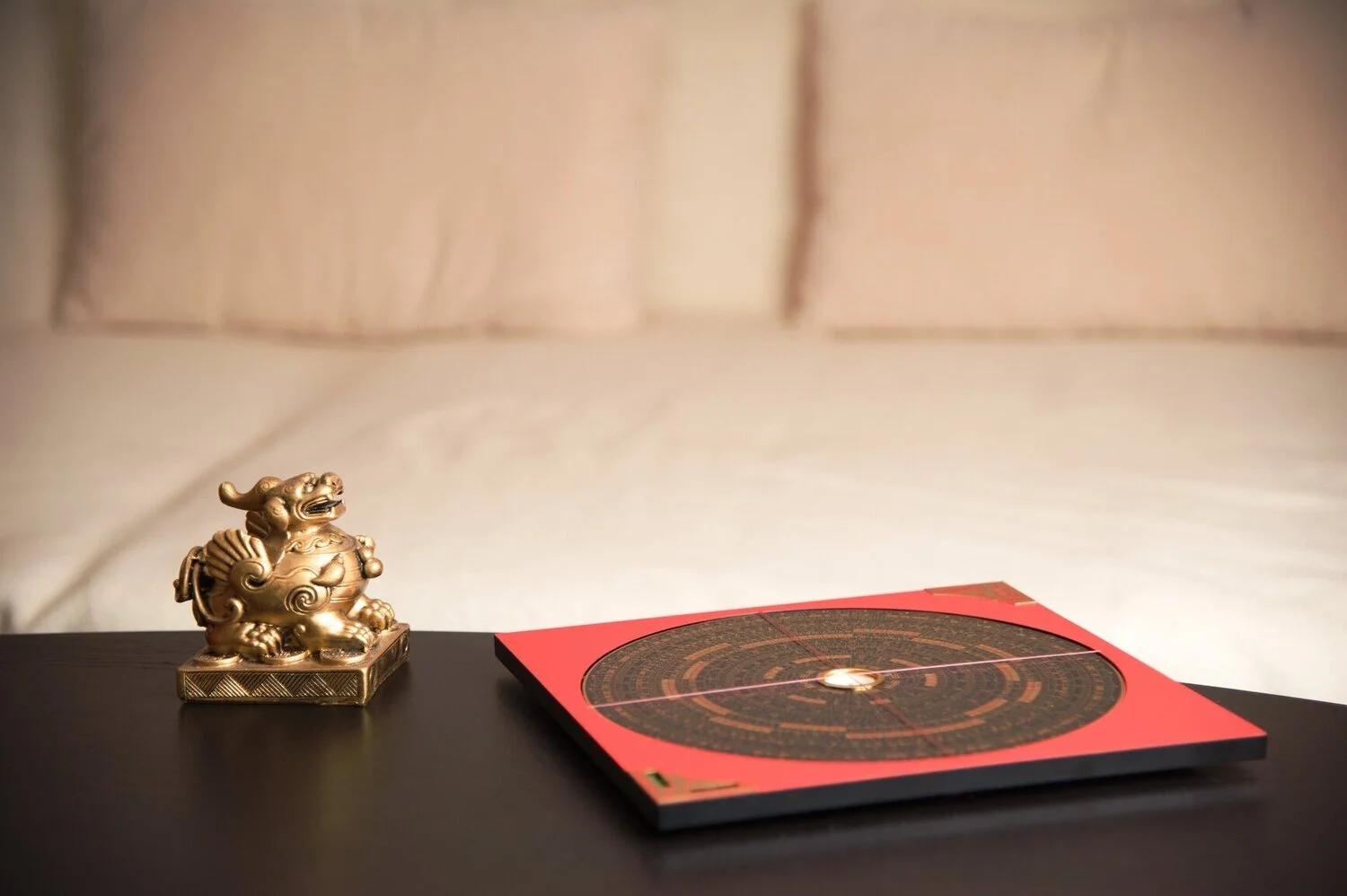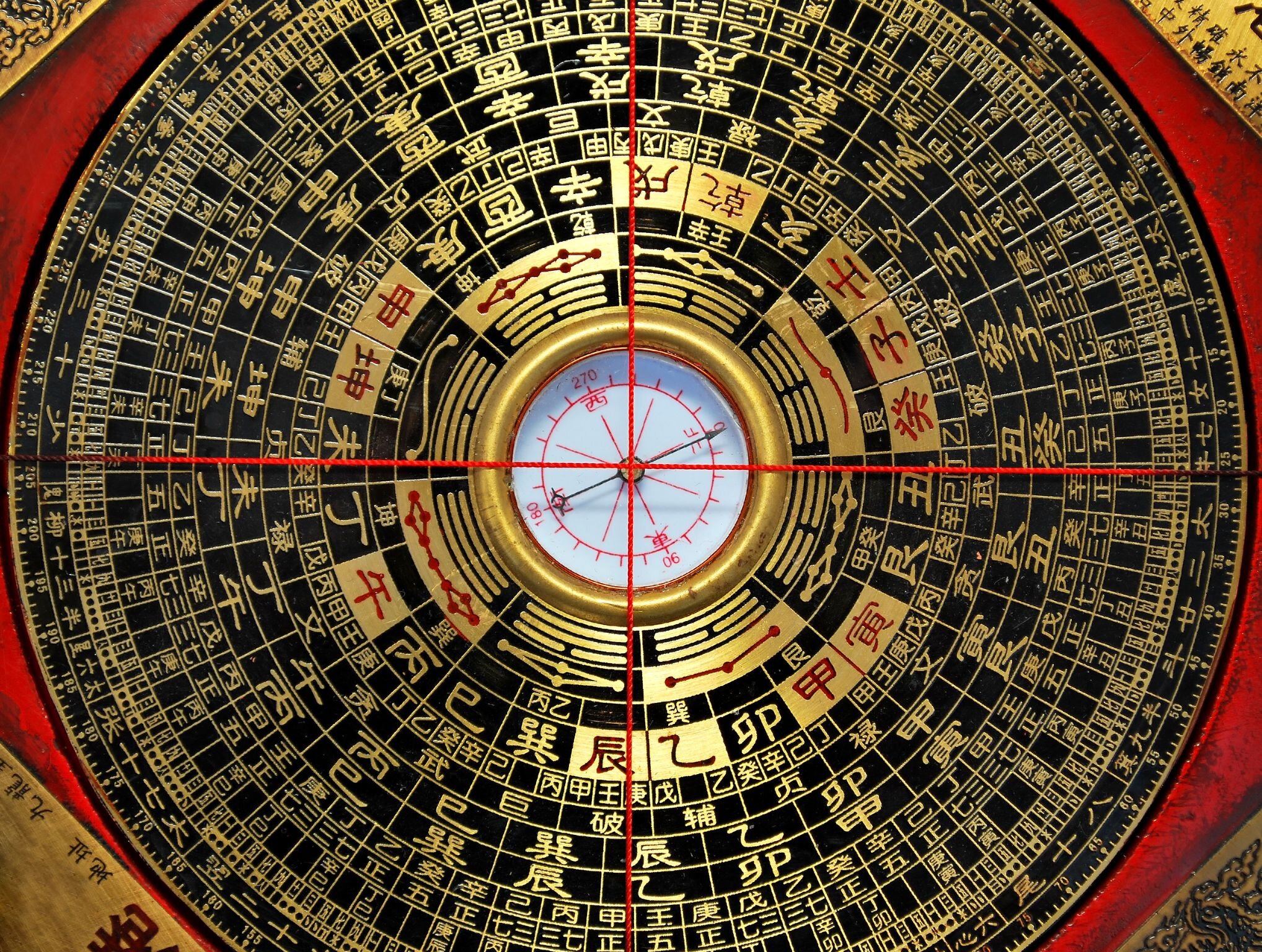
WHAT IS FENG SHUI?
Originating in China almost 6,000 years ago, Feng Shui literally means “wind” (Feng) and “water” (Shui).
It is an ancient method of constructing and optimizing residences and businesses to bring about happiness, abundance, and harmony. It includes architecture, urban planning, interior design, and garden design. Feng Shui involves the placement of objects in relation to the flow of Qi (Chi, 氣) “natural energy”. It also involves the layout, framework, materials, and colors of building structures. These guidelines allow us to make the most ideal arrangement in any given situation.
The term Feng Shui literally translates to "wind-water" in English. The wind moving over the water is said to be perfect Feng Shui. It is one of the Five Arts of Chinese Metaphysics, classified as physiognomy (observation of appearances through formulas and calculations). Feng Shui discusses architecture in allegorical terms of "invisible forces" that bind the universe, earth, and humanity together, known as Chi (Qi).
history of feng shui
Historically, Feng Shui was used to orient buildings in an auspicious manner. Depending on the particular school of Feng Shui being used, an auspicious site could be determined by reference to local features such as bodies of water, stars, or a compass.
Feng Shui was suppressed in mainland China during the state-imposed Cultural Revolution of the 1960s but has since regained popularity.
The Skeptic Encyclopedia of Pseudoscience states that principles of Feng Shui are "quite rational", Many of the teachings of Feng Shui are common sense. For example, if we look at the Bagua, the tool used to do Feng Shui, we see that the element of the South is Fire. If you think of southern exposure, it’s hot. The South side of your building always gets the strongest sun. The element of the North on the Bagua is Water. If you think of the north side of your building, it’s cold, and dark, just like Water. I often have to clean off the moss that grows on the handrails of my front porch, as it’s due North. More on the Bagua later.
THE FIVE ELEMENTS OF FENG SHUI (WU XING 五行)
The system of the Five Elements was used for describing interactions and relationships between phenomena. It is employed in many fields of early Chinese thought, such as Feng Shui, traditional Chinese medicine, music, military strategy, and martial arts. It is also used in Chi Gong, Tai Chi, and Acupuncture. The Five Elements are Wood (木 mù), Fire (火 huǒ), Earth (土 tǔ), Metal (金 jīn), and Water (水 shuǐ). They are the very foundation of Feng Shui and each play a very important role in creating the perfect environment.
Click on each element and read more below the graphics
The Five Elements
asdfasdf
The first element is Wood because it is the beginning of new life; it is the creator of the Five Element cycle. You may have heard that you shouldn’t use Wood furniture as a Wood element, as it is “dead wood” and contains little Ch'i. Actually, it can contain positive energy, if it has had a good history.
“Live Wood” would be a bushy plant such as a "money plant" or jade plant. Plants also filter the air we breathe, so it’s better to use plants than “dead Wood”. Remember to feed and water your plants. If they die, they will hold Sha Ch'i, which is bad. The Wood element can also be pumped up with color green or brown. You can of course use all three together.
Wood represents the directions of East and the Chen Trigram 3 (Family & Health sector). It also represents the Southeast and the Sun Trigram 4 (Wealth sector).
Fire is the most "Yang" of the elements. Because Fire is so Yang, this is the one instance where color does work well. A tea-light or table lamp with a red shade makes a great Fire remedy. Candles are also excellent, but be sure not to leave them unattended.
Fire represents the South and the Li Trigram 9 (Fame & Reputation sector).
Earth element is often confused with soil, which is only part of the element. It also includes rock, clay, glass, and stone. For example, a terracotta pot filled with soil is a perfect Earth element, or a clay statue. Earth colors are yellow, beige but are not quite as effective as the real element itself.
Earth represents the Northeast or the Ken Trigram 8. It also represents the Southwest or the Kun Trigram 2 (Relationships sector). In addition, it represents the "Center" or the Master Trigram 5.
Metal can be found in many forms, such as Silver, Gold, Copper, Bronze and Pewter. You could also use a brass Kwan Yin, three-legged toad or a nice Dragon. Feng Shui is about creating a harmony and balance and it should look attractive in the environment. The colors you should use here are white, gold, and silver.
Metallic paint is excellent. Ralph Lauren has a bunch of metallic colors available, such as “Ballroom Gold”. You can use it sparingly, or really go wild with it, depending on your needs.
Metal is the Tui Trigram 7 in the West. It is also the Chien Trigram 6 in the Northwest (Helpful People & Travel sector).
Water is the key element; we would not exist without it. Our planet and our body is made up mainly of Water. It is a very powerful element to use, it should always be clear and free flowing.
Never let it go stagnant, as this will create many problems. A fountain or aquarium is ideal or a simple fishpond in the garden. Water has always been associated with power. It has been used for thousands of years by Kings and Emperors in the form of protection as in a moat, or a powerful attraction for abundance.
Most prominent cities are either positioned near the Water or have large lakes or rivers close by. Also, people pay premium prices for ocean-side and lakeside homes. The colors blue or black can replace water, but the actual element is most powerful.
Water represents the Kan Trigram 1 in the North (Career sector).
The Bagua
THE BAGUA
The Bagua is an essential tool in the majority of Feng Shui schools. The Bagua (Also Pakua; literally “eight symbols” or “eight areas”) are eight diagrams used in several Chinese doctrines to represent a range of interrelated concepts. Each consists of three lines, each either “broken” or “unbroken,” representing a yin line or a yang line, respectively. Due to their tripartite structure, they are often referred to as “trigrams” in English.
All prior knowledge of Chi, the Yin and Yang Theory, the Yellow River Map, the Luo Shu Turtle,The Eight Trigrams, and The Five Elements combined with the I-Ching to become the Bagua.
The Feng Shui map or Bagua is superimposed over your property, home, office or desk. It reveals areas lacking good Chi, and shows ‘missing areas‘. This alerts the Feng Shui Master to what needs correcting or enhancing.
For tons of details about the bagua, click here
The Luo Shu Turtle
MAGIC SQUARES & TURTLES
Chinese literature dating from as early as 2800 B.C. tells the legend of The "Luo Shu Magic Square" or "scroll of the river Luo". Roughly three thousand years ago in ancient China, a great flood happened. The people, sensing that the river god ("Luo") was upset, tried to offer sacrifices to calm his anger. Each time they made an offering, a turtle would appear from the river.
It had a curious pattern on its shell; there were circular dots of numbers that were arranged in a three by three nine-grid pattern such that the sum of the numbers in each row, column and diagonal was the same: 15.
This number is also equal to the number of days in each of the 24 cycles of the Chinese solar year. In a certain way, this pattern was used by the people to control the river.
The legend of the Luo Shu Turtle is told in The Book of Rites, a canonical book of ancient China, which also relates another story of this kind, the one of a dragon rising from the Yellow River bearing on its scales a diagram known as the Ho Tu or the Yellow River map.
TYPES OF FENG SHUI
Here at Feng Shui Style, we use the Compass School, Form School, and Eight Mansion Theory. We use these schools because they are the oldest forms of Feng Shui, and they have been working for thousands of years. There are several “new age” schools of Feng Shui that have become popular in the West. These schools have attempted to make Feng Shui “easy”. Well, it is not easy. It is very complex. If you have heard that you should orient your Bagua map based on the door, not the compass, you are probably very confused by now. If your Feng Shui Master isn’t using a compass, they are not doing Classical Feng Shui.
FORM SCHOOL
The oldest form of Feng Shui, the Form School (San He) refers to the shape of the environment, such as mountains, rivers, plateaus, buildings, and general surroundings. It considers the four celestial animals, the yin-yang concept and the traditional five elements (Wu Xing: wood, fire, earth, metal, and water).
It was developed by Yang Yun-Sun, Imperial Geomancer to Emperor Hi-Tsung (874-888 AD) and was based in Kiangsi (or Jianxi), a province of Southeast central China.
The four cardinal compass directions are represented by four animals: the Black Turtle of the North, the White Tiger of the West, the Green Dragon of the East and the Red Phoenix of the South.
The Four Celestial Animals
These animals refer to the ideal landforms to look for around the outside of your home. Gentle hills at the back of the house offer protection. These are called “Black Turtle”. The “White Tiger” hill to the West of the house also gives protection (this side should be a bit lower than the opposite East side). The “Green Dragon” hills to the East of the house bring abundance and prosperity – these two landforms should ideally be low hills, other buildings, or trees.
Finally, the “Red Phoenix” or “little footstool” (a tiny hill) in the front of the house needs open space to prosper. It represents your opportunities and financial affairs. The 4 celestial animals are also used inside the house for furniture placement, interior design, etc.
Today using Form School means analyzing natural features such as trees, hills, mountains, rivers and lakes. In the urban environment, this also includes other buildings, walls and fences. Form School is still relevant today, and particularly important in large development sites. In China, a Feng Shui Master can charge up £70.000 ($100,000) to locate a good site and demand for their service is extremely high. In this country and most western countries it is not practiced as much; in fact there are few Masters who are qualified to practice it.
A Luo Pan, or Chinese Compass used for Feng Shui
COMPASS SCHOOL
“Compass School” is a term coined by Westerners to refer to the “Patterns of Chi” or Classical School of Feng Shui. Any true form of Feng Shui should involve a Compass. Hence, this term is somewhat humorous, albeit popular.
Chinese history books describe how around 2005 BC, a turtle emerged from the River Luo with 9 numbers arranged in a grid on his back. The numbers were arranged in such a way that when they were added vertically, horizontally or diagonally, they always added up to fifteen. This is referred to as a “Magic Square”.
This magic square is part of the Bagua, a tool used to do Feng Shui. Compass School superimposes the Bagua onto a floor plan of the dwelling. Each of the 8 outer squares relate to compass directions, and the center square represents the center of your life (or house).
Each compass direction has certain colors and elements associated with it: Water, Wood, Earth, Metal, or Fire. These colors and elements are used to balance and harmonize the space. Each of these areas is called a “gua” in Chinese. “Ba” means eight, therefore, the “Bagua” is “8 areas“. This type of Feng Shui further divides into several sub-schools, described below.
A Luo Pan, or Chinese Compass used for Feng Shui
EIGHT MANSION THEORY (SUB-SCHOOL)
Eight Mansion Theory (Ba Zhai) is used to determine your four lucky and four unlucky directions or areas. The idea is to maximize the compatibility between you and your dwelling.
The Kua or Gua number is how we calculate the lucky directions, or most auspicious energies based on a client’s date of birth.
Each person is either in the East Group or West Group. East Group people have four lucky locations that are opposite to West Group lucky locations. Consequently, it is tricky to Feng Shui a house that contains East Group and West Group people.
For tons of details about Eight Mansion Theory, click here
Flying Star Feng Shui adds the element of time to the mix
FLYING STAR (SUB-SCHOOL)
Flying Star (Xuan Kong) is the most advanced level of Feng Shui and adds the time dimension to a building’s energy. A Luo pan compass is used to calculate the facing and sitting degrees of the structure. The date of construction and facing/sitting degree is used to determine energy patterns within the building.
PYRAMID SCHOOL (NEW AGE SCHOOLS)
The Pyramid School is a contemporary “new age” western adaptation of ancient Chinese Feng Shui, integrating biology, psychology, cultural anthropology, physics and other environmental considerations to assess how an individual experiences their environment. I cannot speak about the accuracy of this form of Feng Shui, since it is typically grouped in with the Black Hat School (see below).
WESTERN/BTB (BLACK HAT SECT TIBETAN BUDDHIST) (NEW AGE SCHOOLS)
The “Black Hat School” of Feng Shui was developed in the mid-1980s by Professor Thomas Lin Yun and is a combination of Tibetan Buddhism, Taoism, Psychology and Traditional Feng Shui. It is more of a spiritual than scientific approach to Feng Shui. There is quite a bit of overlap between the Black Hat School and Classical Feng Shui, but there are also distinct differences.
With Black Hat, the dwelling is divided into eight sections (nine being the center) and a Bagua map is aligned with the entry door, rather than the actual compass directions. I use the compass, because the Bagua correlates to the compass for crucial reasons. For example, the North sector is the Water element. If you align the Bagua based on the door, not the compass, you might end up with the Career (Kan, Water element) sector in the South, but South is represented by the Fire element on the Bagua.
Some masters have great luck practicing Black Hat, but we use the Compass School, Form School, and Eight Mansion Theory because they are the oldest, classical forms of Feng Shui.
















